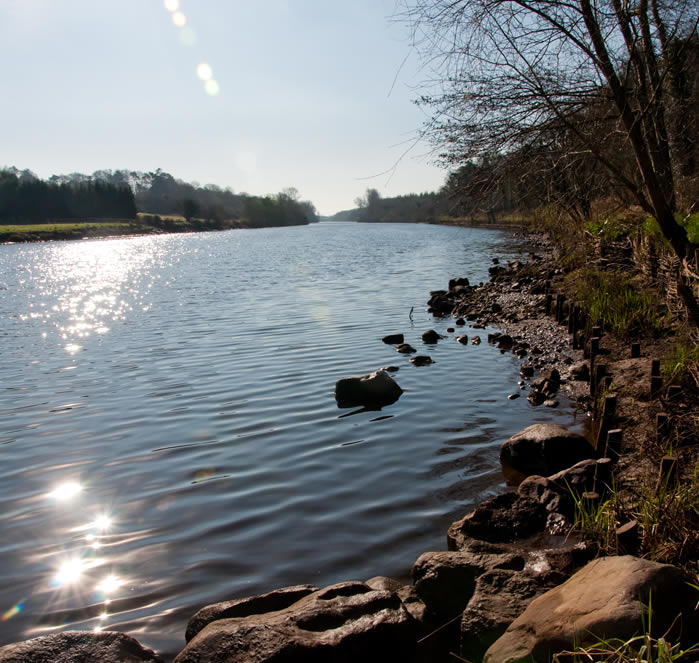5.4 Camus
The red sandstone fragment of the early medieval Camus cross now stands in a graveyard on the west side of the River Bann to the south of Coleraine. The cross is carved with religious scenes on the front and back – the Ark and the murder of Abel on the west face, and the baptism of Jesus and (possibly) his arrest on the east side
Adomnán – Colmcille’s biographer – tells a story which links Colmcille with this place. Adomnán describes how the saint was travelling back to the coast from the Convention of Drum Ceat with Abbot – later Saint – Comgall. Camus was one of Comgall’s monasteries and was probably located at the graveyard site. It overlooks what was a well-known ford on the River Bann and it was probably here that Colmcille crossed the river on his way to Coleraine. The two men sat down to rest,
Water for them to wash their hands was brought to the saints from a nearby spring in a bronze basin. St Columba took it and said to Abbot Comgall who was sat beside him:
‘The day will come, Comgall, when the spring from which this water was fetched for us will be unfit for men to use.’ ‘For what reason will the water of the spring be tainted?’ said Comgall.
‘Because it will be filled with human blood. For my near kindred and your kinsmen according to the flesh (that is the Uí Neíll and the Cruithin) will make war on one another, fighting a battle at this fort of Dún Cethirn near here. One of my kindred will actually be killed in this spring, and his blood with that of others will fill the site of the spring.’
Life of St Columba by Adomnán of Iona, Book I Story 49
The site of Dún Cethirn is thought to be the Giant’s Sconce.
‘Cam uisce’ means ‘bay or river bend’. For thousands of years people have crossed the Bann here at the ford near Loughan Island – as demonstrated by the many archaeological finds from the river. At nearby Mount Sandel archaeologists have found the remains of the oldest known human settlement in Ireland dating back at least 9,000 years

There is a bullaun stone on the north side of the graveyard. The water in the large hollow in this stone is believed to have holy properties and it is said to never dry out.
North Sperrins and the Bann
- 5.1 Droim Ceat, Limavady
According to legend when Colmcille left Ireland it is said that he vowed never again to set foot on Irish soil. However he appears to have returned at least once - for the Convention of Drum Ceat probably in the 570s, here just south of Limavady. The event is recorded...
- 5.2 Giant’s Sconce
From the top of the Giant’s Sconce, it is easy to see why it would make a good place to build a fort. There are views in all directions and it is a short distance by land to the River Bann and the sea beyond. This monument is thought to...
- 5.3 St Patrick’s CofI, Coleraine
The earliest record of Coleraine appears in Adomnán’s Life of St Columba. Adomnán was an Abbot of Iona and wrote his account of Colmcille’s life a century after the saint’s death in 597. Adomnán mentions that Colmcille stayed with the Bishop of Coleraine on his way home from the Convention of Drum...
- 5.4 Camus
The red sandstone fragment of the early medieval Camus cross now stands in a graveyard on the west side of the River Bann to the south of Coleraine. The cross is carved with religious scenes on the front and back - the Ark and the murder of Abel on the...
- 5.5 Ballintemple
It is believed that the first church on this site was founded by St Adomnán (c.628-704), Abbot of the monastery at Iona from 679 to 704 and the author of the Life of St Columba. According to tradition, Adomnán wanted to build his church two miles away at Lisnascreaghog but every time the walls were...










Bòrd na Gàidhlig
Great Glen House
Leachkin Road
Inverness
Scotland, IV3 8NW
(+44) 01463 225454
colmcille@gaidhlig.scot
Colmcille
Foras na Gaeilge, 2-6 Queen Street
Belfast
Northern Ireland
BT1 6ED
(+44) 028 9089 0970
colmcille@forasnagaeilge.ie
Colmcille
Foras na Gaeilge, An Chrannóg
Na Doirí Beaga
Gaoth Dobhair
Donegal, Ireland. F92 EYT3
(+353) 074 9560113
colmcille@forasnagaeilge.ie


